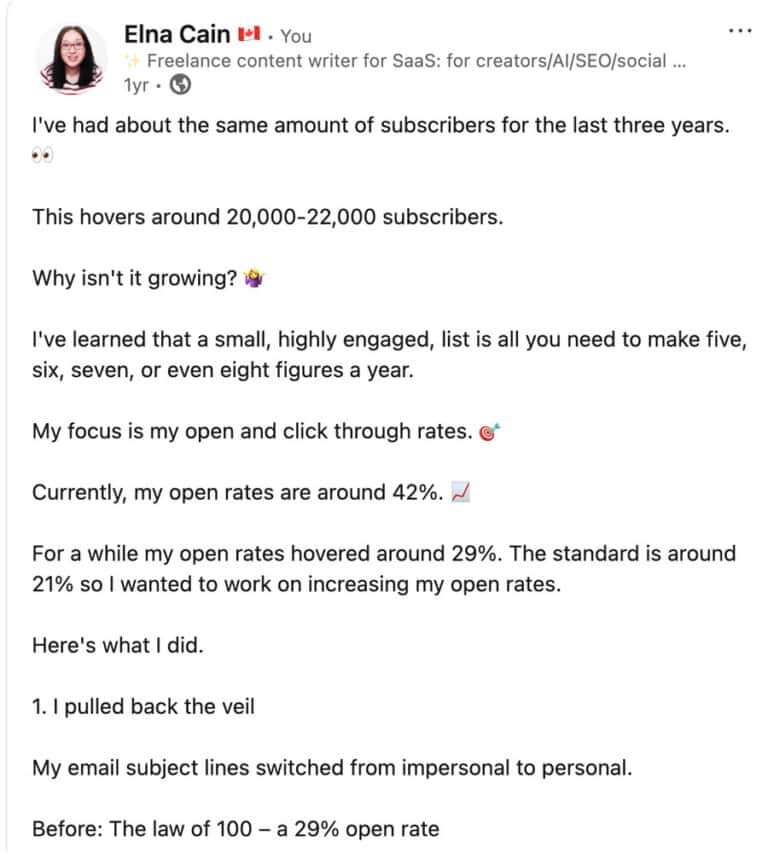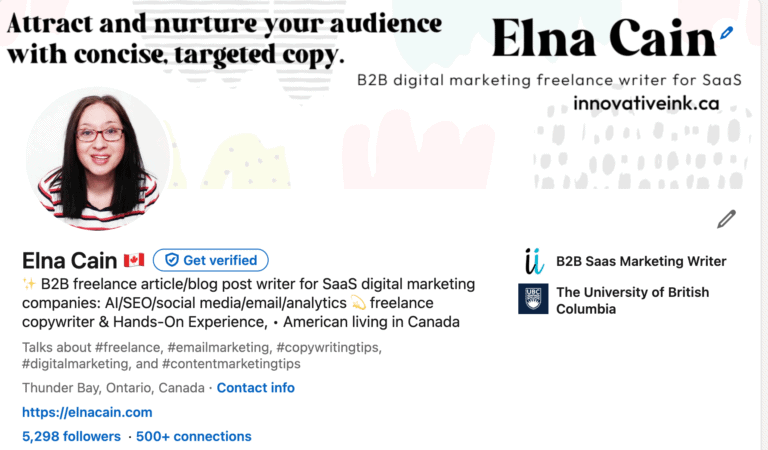I’ve got the ultimate freelance writing portfolio guide for you!
Look – when I started as a new freelance writer, I had no clue how to create a writing portfolio without a BLOG, website, clips or samples….with absolutely NOTHING to my name.
I seriously was freaking out and was a bit scared that I didn’t know what to do.

I mean, how DO you create a legit and credible freelance portfolio so that you can get clients?
In my guide, I’ll show you how you can get published so you can call yourself a true writer!
Because, once you have that first bylined sample in your writing portfolio, then you can attract higher-paying clients.
And the more higher-paying clients you have, the more money you can make freelance writing!
So, bookmark this page (if that is even a thing still) and take notes if you need to!
But, if you don’t have time to read the entire guide, you can watch my YouTube video here (and make sure to subscribe to my channel! Thanks):
What is a Freelance Writing Portfolio?
A freelance writing portfolio shows your latest and best work as a writer.
It’s your proof.
The thing that tells potential clients, “Yes, I know how to write.”
Without a portfolio—even a simple one—it’s really hard to stand out or get taken seriously as a writer online.
Clients want to see what you can do before they even think about hiring you.
That’s why, as a beginner, one of the first things you should focus on is creating your freelance writing portfolio.
It doesn’t need to be fancy or filled with dozens of samples. You just need a few solid pieces that show your skills and your voice.
And you don’t even need a website either!
There are many places you can place your portfolio on, for free too!
Having bylined work in your portfolio is also a huge plus because it does a few things:
- It proves you can actually write. You’re not just saying you’re a writer, you’re showing it.
- It shows you can write for others. Clients love to see that you’ve worked with people before and that you know how to follow directions, meet deadlines, and deliver polished content.
- It highlights your niche expertise. If you want to write in a specific niche (like SaaS, parenting, or health), your portfolio helps you build authority in that space.
- It adds social proof. When your name is on an article published online—even on a small blog—it builds trust. It tells clients, “Other people have trusted me to write for them.”
The key is to get started with what you have and work on improving it over time.
Because if all you ever think is that you need a writing sample on a popular blog or even on a blog in your niche, you may NEVER get started as a freelance writer!
What Makes a Good Writing Portfolio Item?
So, what actually makes a good freelance writing portfolio item?
It really depends on two things: your niche and the writing service you want to offer.
If you’re planning to write Amazon product descriptions—or any kind of product copy—then your portfolio should include examples of that.
And don’t worry if you haven’t landed a client yet.
You can create “mock-ups” of product descriptions for fake or real products just to showcase your style.
Tools like Canva make this super easy.
You can drop in an image of a product and add your own copy beside it. It looks professional and gives potential clients a clear idea of what you can do.
Psst…in my YouTube video, I give a little tutorial on how to create a product description in Canva!
The same idea applies if you want to write emails or social media content.
If you already have an email list, even a small one, you can include screenshots or written examples of your own emails.
And if you’re posting on social media (which you should be doing as a freelance writer), then those posts can also be used as samples.
In fact, using your own email or social media writing is a smart move, especially if you can show the results—like open rates, engagement, or shares.
That’s proof your writing is doing its job, and it’s exactly what clients are looking for.
I do this on LinkedIn a lot. I may post my website traffic results, how I write my client piece or email marketing results.

A strong portfolio doesn’t have to be huge.
It just needs to reflect what you want to be hired for.
So, lead with examples that show off your skills in that specific area, even if they’re self-made.
But, one of the best types of portfolio ideas are blog posts.
Blog posts are versatile and can be used as a way to help clients see how you write.
If you can write a blog post then you can probably write an email, social media post, a landing page or even a sales page.
For more help, enroll in my Writing Sample Masterclass where I show you have to write a blog post as a sample piece.
My portfolio is only made up of blog content but I have written:
- Email campaigns
- Landing pages
- eBooks
- Ads
- Sales pages
What to Include in Your Freelance Writing Portfolio Item
With every portfolio item you add, there are a few non-negotiables.
Your writing sample MUST do a few key things to actually help you get hired:
1. It Needs to Be Error-Free
This might sound obvious, but it’s worth repeating: grammar mistakes, typos, or awkward sentences can instantly turn off a potential client.
Your sample is a direct reflection of your writing skills—so it needs to be polished, professional, and clean.
If proofreading isn’t your strength yet, use a tool like Grammarly, or have a fellow writer give it a once-over before adding it to your portfolio.
2. It Should Show You Know How to Write for a Specific Audience
Are you writing for B2B (business-to-business)?
Then your tone, structure, and examples should sound professional, helpful, and strategic.
Are you writing for B2C (business-to-consumer)?
Your writing should feel more casual, relatable, and benefit-driven.
Clients want to know that you understand their audience—and your sample is the best way to prove it.
3. It Should be Published
This is a big one.
If your writing isn’t published online, meaning it lives on a blog, website, or platform, it can make things harder for you when pitching.
Why?
Because attaching a Google Doc or Word screams amateur.
Clients may assume you’re brand new or that your experience isn’t relevant.
Published samples build credibility and create a sense of trust.
Even if it’s your own blog, or something you wrote for Medium or LinkedIn, it still shows you’re taking your writing seriously.
The good news?
It’s super easy to publish your work. You don’t need to wait for a client to say yes. You can:
- Start a free blog using WordPress
- Publish on Medium or LinkedIn Articles
- Use Contena Publishing, Clippings.me, or Journo Portfolio
- Or even create a static portfolio site on Notion, or Canva
You need that published link.
It’s what allows you to confidently say, “Here’s a sample of my writing—no downloads required.”
Bottom line: treat every portfolio piece like a mini job application.
It should be clean, audience-specific, and easy to access.
That’s how you’ll stand out, even as a beginner.
My suggestion is to have at least three relevant writing samples in your portfolio BEFORE you start pitching to gain freelance writing jobs.
How to Find the Perfect Topic for Your Portfolio Piece
In my video, I walk you through how to find a topic to write about as your first writing sample.
Once you know your niche, start saving websites in that topic that you want to write for, or feel is your target audience.
For example, I’m in the SaaS writing niche and I looked at Omniscient’s blog to see if this is a potential client.
Their blog has author bios from a different people, so that quickly tells me they probably hire writers.

From there I can feed their blog into ChatGPT and have it find content gaps to write about.
I can look at the list ChatGPT gave me and pick a topic. In my video I picked a topic around YouTube marketing for brands.
ChatGPT said that Omniscient doesn’t have many or any content around YouTube marketing.
This would make a great writing sample to attract clients like Omniscient.
Sharing Your Freelance Writing Portfolio When You Don’t Have a Website
So, once you have your writing samples ready, the next step is knowing where to put them.
Because if no one can find or read your writing samples easily, they won’t help you land clients.
Ideally, your freelance writing portfolio should live somewhere online, so it’s just a click away when you’re pitching or networking.
But, what if you don’t have anything online, like a blog or website?
You don’t need a website right away, especially if you’re just getting started.
There are several beginner-friendly platforms where you can create a professional-looking portfolio for free.
My top two recommendations? LinkedIn and Medium.

LinkedIn isn’t just some bro marketer’s platform, it’s one of the best tools you can use to market yourself as a freelance writer. You can:
- Add your samples under the Featured section on your profile
- Post short-form or long-form content directly on your feed
- Show potential clients that you’re active and engaged in your niche
It doubles as a portfolio and a place to network with editors, content managers, and business owners.
That’s why, if you’re not ready to build a website, I always recommend setting up a solid LinkedIn profile first.
Medium

Medium is also a great option, especially if you want to write in a more blog-style format, like me!
You can publish articles for free, use tags to get found by readers, and create your own “publication” as a mini writing hub.
Bonus: When someone clicks your article link, it looks clean and professional, even if it’s your very first sample.
There are other portfolio platforms you can use like Notion or Contena Publishing. But Medium and LinkedIn are well known in the content space so publishing on those platforms is your best bet to get a potential lead.
But that’s not to say you can’t have more than one freelance writing portfolio.
If possible, have a LinkedIn portfolio, Medium portfolio, Notion portfolio, ClearVoice portfolio and more.
The more you have the better you are at attracting more leads that lead to high-paying freelance writing jobs.
But, What If I Have Absolutely No Experience?
Look –
You have to start somewhere. And that somewhere is choosing your writing niche.
Your writing niche is the topic or industry you’ll focus on, and it plays a huge role in what goes into your freelance writing portfolio.
Because if you don’t know what kind of writing you want to do or who you want to write for, it’s going to be really hard to create strong, relevant samples that attract the right clients.
I mean, this is EXACTLY what I did. I had one sample about the culinary arts, and one sample about seasonal depression and one sample about natural parting tips.
Does that SCREAM a high-paying freelance writer that knows their stuff?
No. Now, you might be thinking, “But Elna, look at you now? You figured it out and you are successful.”
True, true, but that was in 2014 when there weren’t a lot of freelance writers.
Ever since COVID, there has been an influx of freelancers and content platforms and it makes it a tad more challenging to get noticed.
So, when you pick the wrong niche, like one you don’t enjoy, or one that’s hard to break into as a beginner, you’ll probably end up constantly getting writer’s block and building up anxiety because you know you can’t write about HR practices for tech companies.
Worse, you’ll end up attracting clients you don’t really want to work with.
But when you pick the right niche—one you’re excited about, or already know something about—you’ll find it much easier to create content ideas, write strong samples, and speak confidently when pitching.
And remember, your first writing niche doesn’t have to be your forever niche.
You’re allowed to test things out, try a few types of content, and see what clicks.
This is what I teach because this is what I did!
But starting with a niche helps you create targeted portfolio pieces that make it clear to potential clients:
- You understand their industry
- You know how to talk to their audience
- And you’ve got the writing skills to back it up
So take the time to think it through and ask, “What topics do you enjoy?”
“What industries are hiring?”
“What kind of content do you want to write?”
Your answers will shape the kind of writing portfolio that gets you noticed (and hired).
What Not to Include in a Freelance Writing Portfolio
Not every piece of content is created equal.
If you don’t want to write email newsletters, then don’t include those in your portfolio.
Your writing portfolio should act like a magnet.
You want it to attract the right projects and repel the ones you’re not interested in.
That means only showcasing the type of content you want to get hired for.
But beyond that, there are a few other types of content you should avoid including, especially as a beginner:
1. Personal Blog Posts that Aren’t Niche-Relevant
If you wrote a post about your weekend or your favorite TV show on your old blog, that’s great—but it won’t help you land a client in the health, parenting, or SaaS space.
Keep your portfolio focused on client-facing writing that matches your niche and ideal work.
This also means no personal opinion pieces you may have submitted to a magazine.
As much as you feel a magazing writng samples would help you land clients work, most businesses won’t read a personal opinion piece as it’s not relevant to their business.
2. School Essays or Academic Papers
These are usually written in a formal tone and don’t reflect the conversational, clear style most businesses want.
Even if it’s well-written, it won’t show that you can write for real-world clients.
Plus, the topics aren’t relevant to business writing.
But it is possible to transition from academic to content writing!
3. Creative Writing, Fiction, or Poetry
Unless you’re specifically offering creative writing as a service, skip the fiction samples.
Most clients aren’t looking for storytellers in that format—they want writers who can inform, educate, or sell.
4. Ghostwritten Work You Can’t Legally Share
If you want to do ghostwriting and you wrote something for a client under a ghostwriting agreement and didn’t get permission to use it, you shouldn’t include it.
Instead, you can create a similar spec sample to show your skills in that style.
This is a mock sample of what you did for your ghostwriting clients.
It’s Time to Create a Freelance Writing Portfolio
Don’t let not having a website or experience stop you from creating a writing portfolio!
If you need help, take my writing sample masterclass and start a LinkedIn profile and publish your samples there and start marketing!
Let me know in the comments where you are in your freelance writing journey! I love to hear where you’re at so I can help you better!




4 Comments